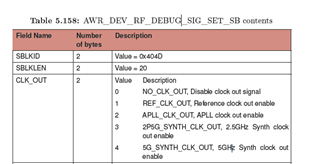Tool/software:
Hello,
On the AWR2944EVM, I have been trying to activate the G15 FRAME_START signal (mode 13) with the following code in the mssgenerated ti_pinmux_config.c, after reading a very similar E2E post to this. I am working with the OOB TDM demo. PIN_PULL_DIRECTION seems to no longer exist anymore so I replaced it with PIN_PULL_DOWN.
{
PIN_PAD_AZ,
( PIN_MODE(13) | ( PIN_PULL_DISABLE & PIN_PULL_DOWN) )
},
I then regenerate the binaries using gmake mmwDemoTDM, having slightly modified it so that the syscfg files are not regenerated.
I would expect the D6 LED to light up on every frame start, since D6 is connected to MSS_GPIO_2, which is the ball name of G15. However, the LED does not light up at all and no signal shows up on the oscilloscope either.
1. What am I doing wrong? Do I need to modify/add more code?
2. Is the solder around the D6 LED not the right place to measure from? If not, where should I measure from?
3. For alternatives, I have tried looking for the R15 and T17 pads, but they weren't exposed on my unmodified AWR2944EVM or I couldn't find them. It would be great if you could point me toward them.
Thank you!
Best,
Aaron



